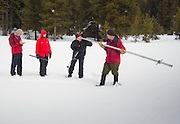
May 1, 2017, Submitted by Pamela Martineau to ACWA. The final manual snow survey for water year 2016-’17 at Phillips Station in the Sierras today revealed a snow water content of 27.8 inches or 190% of the long-term average, officials with the California Department of Water Resources announced. Electronic measurements statewide indicate a snowpack water content that is 196% of the May 1 average, or 42.5 inches.
“California’s cities and farms can expect good water supplies this summer,” said DWR Acting Director Bill Croyle. “But this ample snowpack should not wash away memories of the intense drought of 2012-2016. California’s precipitation is the most variable in the nation, and we cannot afford to stop conserving water.”
The snow water content of the northern Sierra snowpack is 199% of average or 39.9 inches; the central and southern Sierra readings are 202% of average or 47.1 inches and 180% of average or 37.6 inches, respectively. Today’s readings will be used by hydrologists to forecast spring and summer snowmelt runoff into rivers and reservoirs. The melting snow supplies approximately one-third of the water used by Californians.
Frank Gehrke, chief of the California Cooperative Snow Surveys Program, conducted DWR’s survey today at Phillips and said 2017 has been “an extremely good year in terms of the snowpack.”
Gehrke said the snowpack is encouraging in terms of surface water supplies.
“The thing we’re looking out for is primarily the southern Sierra, where we have full reservoirs and in some cases a huge snowpack,” he said. “We want to make sure that we prudently manage that so we don’t cause any downstream issues.”
California’s reservoirs are fed both by rain and snowpack runoff. A majority of the state’s major reservoirs are above normal storage levels for today’s date. Lake Oroville in Butte County, the State Water Project’s principal reservoir, is 91% of average for the date (74% of its 3.5-million acre-foot capacity). Shasta Lake north of Redding, the federal Central Valley Project’s largest reservoir with a capacity of 4.5 million acre-feet, is at 109% of average (94% of capacity).
Earlier this month, DWR increased its estimate of this year’s SWP supply to 100% of requests for contractors north of the Sacramento-San Joaquin Delta and 85% of requests for other contractors, the
Electronic snowpack readings are available at the California Data Exchange Center’s (CDEC) Snow Water Equivalents webpage, For earlier readings, click the calendar icon below the map, select a date, then Refresh Data.
Water Year 2017’s precipitation can be found at CDEC’s Precipitation page. Look in the right-hand column for the Northern Sierra 8-station index for updated rainfall readings in the critical northern portion of the state, as well as the San Joaquin 5-station and Tulare Basin 6-station links.
For a broader snapshot of current and historical weather conditions, see DWR’s Water Conditions and Drought pages.
(Frank Gehrke, chief of the California Cooperative Snow Surveys Program, and others conduct DWR’s survey at Phillips Station in February.)

